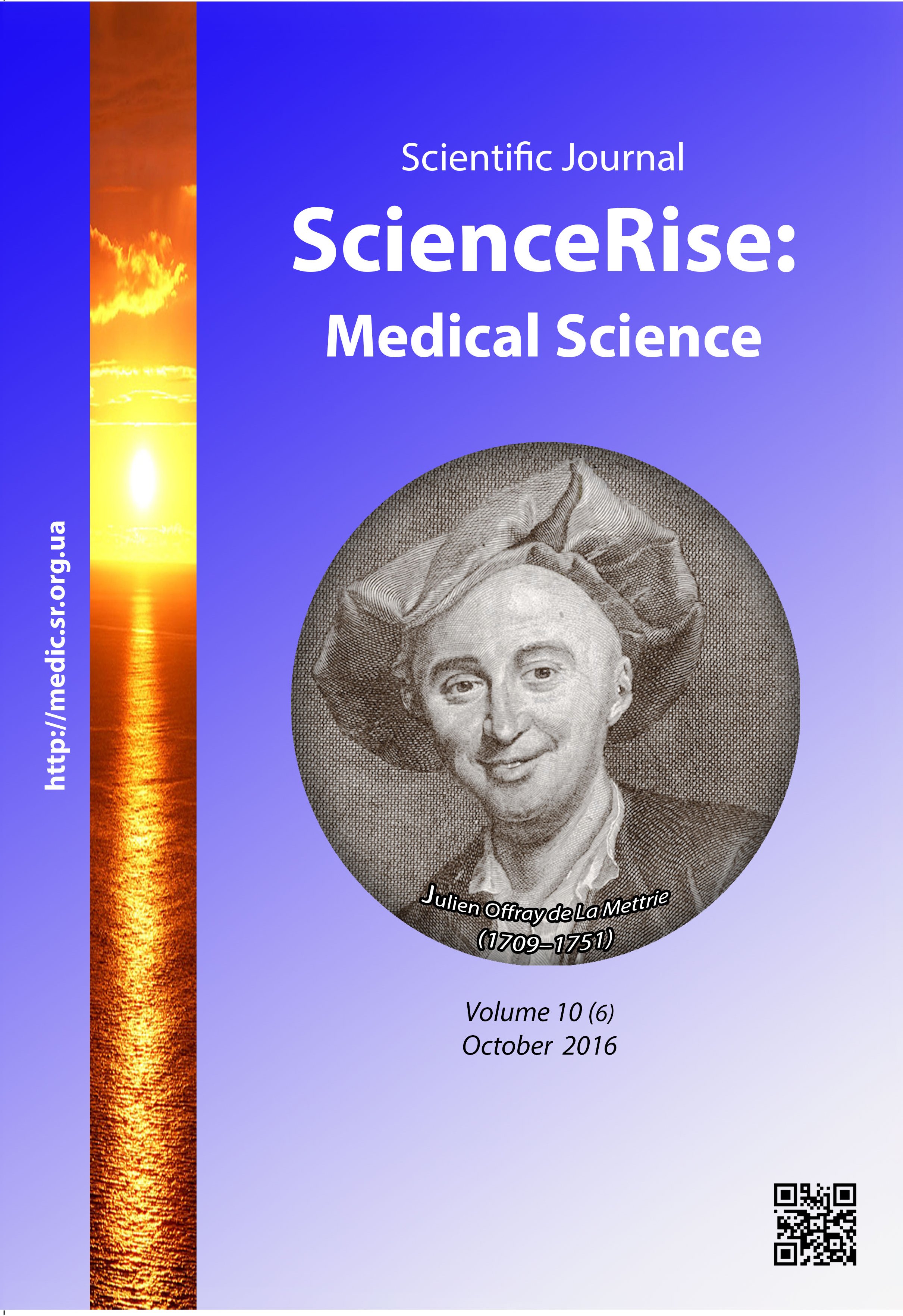The results of two-stage treatment scheme application in patients with hairy cell leukemia
DOI:
https://doi.org/10.15587/2519-4798.2016.79718Keywords:
hairy cell leukemia, treatment, interferon-α, 2-chlorine deoxyadenosine, complication, remission, relapse, survivalAbstract
The analogues of purine nucleosides (pentostatin, cladribine) stay the first line preparations for today. But their use can cause the deep leucopenia and thrombocytopenia that in its turn increases the risk of bacterial, viral and fungal infections, dangerous for the patients’ life. The use of ITF α before 2-СdA course favors the renewal of marrow function and decrease of cytopenia that in its turn allows raise the treatment efficacy and avoid the heavy complications at с 2-СdA therapy.
Aim: To analyze the efficacy of two-stage way of treatment in patients with HCL.
Methods: The two-stage scheme of HCL treatment was used in 22 patients (14 men and 8 women), whose age median was 49,5 years. At the first stage the ITF α treatment was carried out during 2-4 months. At the second stage of treatment at the improvement of the general patient’s state and hemogram indices, the 2-СdA course was prescribed. Statistical analysis of material was carried out using the packages of applied programs STATISTICA for Windows 5,0. The dynamics of parametric parameters was assessed with the help of Wilcoxon pair criterion. The value р<0,05was considered as a reliable difference.
Results: In the result of treatment the full clinical-hematological remission was fixed in 95,5 % of patients, in 4,5 % the partial response to the therapy was fixed. The relapse of disease appeared in 18,2 % of patients during 6-87 months. The analysis of event-free survival (EFS) of patients with HCL after two-stage treatment demonstrated that it is impossible to take into account the median of event-free life of these patients, because the relapse of disease was fixed in less than 50 % of patients, at the same time 25 % of studied persons lived 43,87 months (low quartile).
Conclusions: The two-stage method of treatment of patients with HCL allows receive result without heavy complications of the therapy. Such treatment tactics is expedient in patients at the later stages of disease and at significant cytopenia
References
- Piris, M., Foucar, K., Mollejo, M. et. al.; Swerdlow, S. H., Campo, E., Harris, N. L., Jaffe, E. S., Pileri, S. A., Stein, H. et. al. (Eds.) (2008). Splenic B-cell lymphoma/leukaemia: unclassifiable. WHO Classification of Tumours of the Haematopoietic and Lymphoid Tissues. Lyon: IARC Press, 191–193.
- Forconi, F. (2010). Hairy cell leukaemia: biological and clinical overview from immunogenetic insights. Hematological Oncology, 29 (2), 55–66. doi: 10.1002/hon.975
- Jones, G., Parry-Jones, N., Wilkins, B., Else, M. Catovsky, D. (2011). Revised guidelines for the diagnosis and management of hairy cell leukaemia and hairy cell leukaemia variant*. British Journal of Haematology, 156 (2), 186–195. doi: 10.1111/j.1365-2141.2011.08931.x
- Grever, M. R. (2009). How I treat hairy cell leukemia. Blood, 115 (1), 21–28. doi: 10.1182/blood-2009-06-195370
- Yu, Y.-B., Li, C.-Y., Chen, C.-C., You, J.-Y., Chau, W.-K., Hsu, H.-C. et. al. (2007). Combined Treatment with Splenectomy and Cladribine in Hairy Cell Leukemia in Taiwan: A Clinicopathologic Study of 5 Cases. Journal of the Chinese Medical Association, 70 (12), 551–555. doi: 10.1016/s1726-4901(08)70059-5
- Else, M., Dearden, C. E., Matutes, E., Garcia-Talavera, J., Rohatiner, A. Z. S., Johnson, S. A. N. et. al. (2009). Long-term follow-up of 233 patients with hairy cell leukaemia, treated initially with pentostatin or cladribine, at a median of 16 years from diagnosis. British Journal of Haematology, 145 (6), 733–740. doi: 10.1111/j.1365-2141.2009.07668.x
- Dearden, C. E., Else, M., Catovsky, D. (2011). Long-term results for pentostatin and cladribine treatment of hairy cell leukemia. Leukemia & Lymphoma, 52 (sup2), 21–24. doi: 10.3109/10428194.2011.565093
- Robak, T. (2011). Hairy-cell leukemia variant: Recent view on diagnosis, biology and treatment. Cancer Treatment Reviews, 37 (1), 3–10. doi: 10.1016/j.ctrv.2010.05.003
- Cornet, E., Delmer, A., Feugier, P., Garnache-Ottou, F., Ghez, D., Leblond, V. et. al. (2014). Recommendations of the SFH (French Society of Haematology) for the diagnosis, treatment and follow-up of hairy cell leukaemia. Annals of Hematology, 93 (12), 1977–1983. doi: 10.1007/s00277-014-2140-y
- Sigal, D. S., Sharpe, R., Burian, C., Saven, A. (2010). Very long-term eradication of minimal residual disease in patients with hairy cell leukemia after a single course of cladribine. Blood, 115 (10), 1893–1896. doi:
- 10.1182/blood-2009-10-251645
- 11. Naik, R. R., Saven, A. (2012). My Treatment Approach to Hairy Cell Leukemia. Mayo Clinic Proceedings, 87 (1), 67–76. doi: 10.1016/j.mayocp.2011.09.001
- Zinzani, P. L., Pellegrini, C., Stefoni, V., Derenzini, E., Gandolfi, L., Broccoli, A. et. al. (2010). Hairy cell leukemia. Cancer, 116 (20), 4788–4792. doi: 10.1002/cncr.25243
- Cannon, T., Mobarek, D., Wegge, J., Tabbara, I. A. (2008). Hairy Cell Leukemia: Current Concepts. Cancer Investigation, 26 (8), 860–865. doi: 10.1080/07357900801965034
Downloads
Published
How to Cite
Issue
Section
License
Copyright (c) 2016 Наталія Володимирівна Пеленьо

This work is licensed under a Creative Commons Attribution 4.0 International License.
Our journal abides by the Creative Commons CC BY copyright rights and permissions for open access journals.
Authors, who are published in this journal, agree to the following conditions:
1. The authors reserve the right to authorship of the work and pass the first publication right of this work to the journal under the terms of a Creative Commons CC BY, which allows others to freely distribute the published research with the obligatory reference to the authors of the original work and the first publication of the work in this journal.
2. The authors have the right to conclude separate supplement agreements that relate to non-exclusive work distribution in the form in which it has been published by the journal (for example, to upload the work to the online storage of the journal or publish it as part of a monograph), provided that the reference to the first publication of the work in this journal is included.









